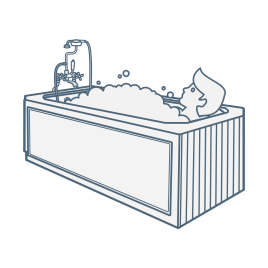If you are in the process of renovating a bathroom or looking towards whether you should invest in one to sell, a common question asked is whether you should buy a new bath to add value.
Practically speaking, a bath – depending on the type installed – can cater for a wider pool of people from families with younger children to shared households, so is likely to attract more potential suitors for the house as a whole. Understandably, more demand can help to increase the final selling price providing the house as a whole is attractive, and the state of the bathroom is in a fairly good condition.
It is worth remembering that the condition of the bathroom as a whole is likely to be the big factor people consider when looking to buy, and if they feel work needs doing to it to cater for their own personal taste or to bring it up to a good standard, it is likely to lead to a lower offer being made.
However, estate agents do tend to advise never to spend heavy on key areas like bathrooms and kitchens prior to selling as there is every chance what you do may get re-renovated again, which is lost money for you unless you get value from it yourself before selling. As such, if you are planning to move, it may be a case of looking at how you can best make the space look more presentable or give some quick TLC without going through a costly and time-consuming full renovation.



